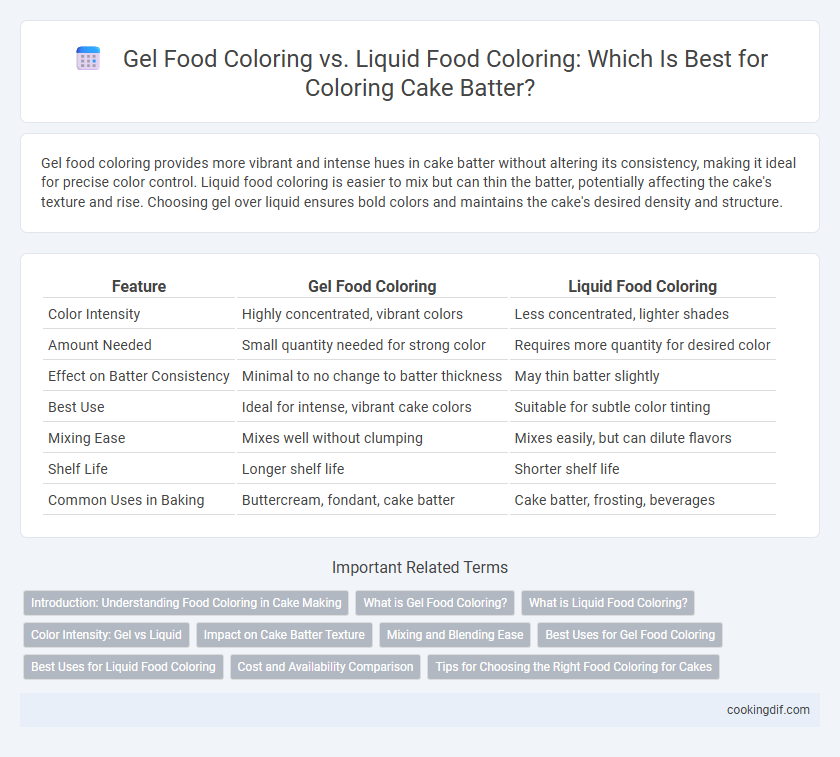Gel food coloring provides more vibrant and intense hues in cake batter without altering its consistency, making it ideal for precise color control. Liquid food coloring is easier to mix but can thin the batter, potentially affecting the cake's texture and rise. Choosing gel over liquid ensures bold colors and maintains the cake's desired density and structure.
Table of Comparison
| Feature | Gel Food Coloring | Liquid Food Coloring |
|---|---|---|
| Color Intensity | Highly concentrated, vibrant colors | Less concentrated, lighter shades |
| Amount Needed | Small quantity needed for strong color | Requires more quantity for desired color |
| Effect on Batter Consistency | Minimal to no change to batter thickness | May thin batter slightly |
| Best Use | Ideal for intense, vibrant cake colors | Suitable for subtle color tinting |
| Mixing Ease | Mixes well without clumping | Mixes easily, but can dilute flavors |
| Shelf Life | Longer shelf life | Shorter shelf life |
| Common Uses in Baking | Buttercream, fondant, cake batter | Cake batter, frosting, beverages |
Introduction: Understanding Food Coloring in Cake Making
Gel food coloring offers more concentrated pigments compared to liquid food coloring, allowing for vibrant, intense hues with minimal impact on cake batter consistency. Liquid food coloring can dilute the batter, potentially altering texture and baking times due to its higher water content. Choosing gel food coloring enhances color precision and maintains the structural integrity of cake batter during the mixing and baking processes.
What is Gel Food Coloring?
Gel food coloring is a highly concentrated, thick dye used to achieve vibrant and consistent colors in cake batter without altering its consistency. Unlike liquid food coloring, gel formulas contain less water, making them ideal for maintaining the desired texture of cakes while providing intense pigmentation. This type of coloring is preferred by professional bakers for its ability to produce bold hues with minimal product use and reduced risk of batter thinning.
What is Liquid Food Coloring?
Liquid food coloring is a water-based dye used to tint cake batter, offering vibrant hues but potentially altering the batter's consistency when added in large amounts. It is widely available, easy to mix, and ideal for pastel shades or subtle color adjustments in cakes. Unlike gel food coloring, liquid coloring may require careful measurement to avoid thinning the batter and affecting the final texture.
Color Intensity: Gel vs Liquid
Gel food coloring delivers more vibrant and intense hues compared to liquid food coloring, making it ideal for achieving vivid cake batter colors without altering the batter's consistency. Liquid food coloring tends to dilute the batter and produces softer, less saturated colors, which may require larger quantities to match the intensity of gel colors. For bakers seeking bold and precise color results, gel food coloring offers superior pigmentation and better control over the final shade.
Impact on Cake Batter Texture
Gel food coloring offers intense pigmentation without changing the cake batter's consistency, preserving the intended texture and structure. Liquid food coloring adds moisture, which can thin the batter and potentially result in a denser or less airy cake. Choosing gel over liquid food coloring ensures vibrant color while maintaining optimal batter viscosity and final cake texture.
Mixing and Blending Ease
Gel food coloring offers superior mixing and blending ease in cake batter due to its concentrated formula, which ensures vibrant color with minimal liquid addition, preserving batter consistency. Liquid food coloring tends to dilute batter, potentially affecting texture and requiring more thorough stirring to achieve even color distribution. Bakers often prefer gel colors for smoother integration and more consistent, vivid results in cake decorating.
Best Uses for Gel Food Coloring
Gel food coloring is ideal for cake batter when vibrant and intense colors are desired without altering the consistency of the batter. Its concentrated formula ensures minimal impact on the moisture balance, making it perfect for recipes requiring precise texture control. Gel colors are especially effective for deep hues like red, blue, and green, providing consistent and bold results in both buttercream and fondant applications.
Best Uses for Liquid Food Coloring
Liquid food coloring is ideal for cake batters that require subtle color changes without altering the batter's consistency, making it perfect for lighter cakes and basic recipes. It blends smoothly into wet ingredients, ensuring even color distribution in cakes, cupcakes, and frostings where a softer hue is desired. However, liquid food coloring may dilute batter slightly in delicate recipes, so it's best used in cakes with sturdy textures or higher moisture content.
Cost and Availability Comparison
Gel food coloring offers a more concentrated pigment, often requiring less quantity to achieve vibrant colors, which can be more cost-effective over time despite a higher upfront price. Liquid food coloring is widely available and typically less expensive per bottle but may dilute cake batter, potentially requiring more product to reach the desired hue. Both types are accessible in major grocery stores and online, though gel colors are more commonly found in specialty baking stores.
Tips for Choosing the Right Food Coloring for Cakes
Gel food coloring offers intense pigmentation with minimal moisture, making it ideal for cake batter to achieve vibrant hues without altering texture. Liquid food coloring, while easier to mix, can dilute the batter, potentially affecting consistency and baking results. Select gel colorings for stable, vivid color and use liquid versions primarily for lighter coloring needs or delicate cake batters where moisture balance is critical.
Gel food coloring vs Liquid food coloring for cake batter Infographic

 cookingdif.com
cookingdif.com